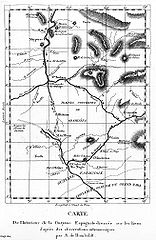| Meeting 11 • 14 February 2012 • Tuesday |
Version: |
|
picture of the week |
thought-bite of the week: |
|
|
"Rivers have only a slight, often imperceptible fall.… We stopped by the mouth of the Caño de la Triguera… to measure the speed of the current, which was 2.56 feet an hour." |
|
mini-text of the week (start): "In this interior of a new continent you get used to seeing man as not essential to the natural order…" Humboldt, "Personal Narrative", from Jaguars and Electric Eels, ed. & trans. Wilson, pp. 99 (read more) |
|
(X') = anticipated time in minutes (total=75) |
(0001) etc.=item in Humboldt Project document collection |
|
Key to notes added AFTER the class meets: |
|
|
√ = topic / activity that was adequately dealt with during the class |
+ = topic that was started but needs more attention & will be resumed at next / subsequent meeting(s) |
|
- = a topic / activity that was proposed though not begun, but will be taken up later |
|
|
Italic bold green text like this = comments after the meeting |
|
|
√ |
(5') This week's thought-bite: the constant measuring and the tiny gradations; Lewis & Clark and the Willamette; science shows that Kansas is as flat as a pancake Followup about words for "science", "scientist", and the specific sciences: "physico-mathematicall experimentall" (Bryson, book about Royal Society). |
|
+ |
(5') NEW ON WEBSITE: "Related Events" (linked from TOC) and "PSU Sustainability Calendar"• Wednesday, February 22, 5-6:30 pm "Payment for Ecosystem Services in the Ecuadorian Andes,"Kathleen Farley, San Diego State University PSU Institute for Sustainable Solutions job opportunities through the ISS - this course adds to your competitive advantage (if you're doing OK in it) |
|
+ |
(15') What happens when you read Darwin? Data, amazing powers of observation, structure of argument, presentation of argument ("rhetoric") - appeals to common sense, shared experience, admission of uncertainty; God and Creation in The Origin of Species. Similar reading experiences: Geneva Convention, Federalist Papers, maybe Hobbes/Locke/ Smith, probably not Newton. So what can the educated citizen read while we wait to see what today's classics will be? (periodical press; local, quotidien; long-term knowledge). How do educated citizens become capable writers? Small groups: Where do you get your citizen information, and how do you check it out? |
|
√ |
(20') Hands-on activity: Getting a sense of topographical mapping by plotting our heights onto a grid and drawing the lines that connect equal (iso-) heights. This was also the basis for H's path-breaking documentation of climate and life-form zones. More about that ("Chimborazo" - see Helferich, Chapter 9) next meeting. |
|
+ |
(20') Exploring group projects: a) trial organization of groups by categories (majors? definite ideas already for projects? math people? foodies? outdoor interests? making things? travel background? hobbies?) b) re-grouping according to suggested projects: OMIS Planet under Pressure; PSU Earth Day; Earth Day with Alex at a Humboldt-named school; designing a Humboldt-related learning garden or specimen collection; planning initial contact with Humboldt-named schools; researching Humboldt-named schools; re-branding a Humboldt-named school (colors, totem animal /plant, mascot & costume, rally/same implement, cheer, events); familiarizing stakeholders with Humboldt; planning the model "Humboldt Box"; adaption of lesson plans for Humboldt-related content (organized according to subject area, or according to age level); grant research and draft proposal. NOTE: There is no plan to sell anything to the schools. They have no money for that. They can be attracted to the Project in only two ways: a) Free resources ready to use right out of the box. b) The prospect of grant money that somebody gets for them. Here is Enchanted Learning - but one of many sources of learning activities, especially for younger learners. Here's their "Explorers" page about Humboldt. Here's their section about "astronomy:Earth", with activities that could be inspiration for learning activities for Humboldt-named schools. here is "ThirteenEd Online", about lesson plans (example: math) |
|
√ |
(5') Preview of writing about Humboldt-related species: Go to the Humboldt Project link to Humboldt-related species (or use some other resource), choose your species, read up on it, and think about which age level of learner / public you will write for: elementary, middle school, high school (including AP), general-public sign at zoo / botanical center. Details to come at next meeting. |
|
√ |
(5') Checkups & Previews: Reminder about "My Education" writing assignment, with followup: holding government to eduational standards. See "schedule and assignments" page (week 4) for directions about getting smart phone apps for the course. (WWHD?) What shall we do with/to the people who haven't gotten on board the SINQing Humboldt Canoe - haven't come forward with information about their interests and skills? Maybe we can find an idea in Walls's description of loading the canoe.:-) Upcoming: presentation about society back then (and any time before 1800 or so), to help understand how H related to people of other classes / races (teaser: When was it that someone's ears first popped with a change in altitude?) Focus of "interpreting the past" to |

